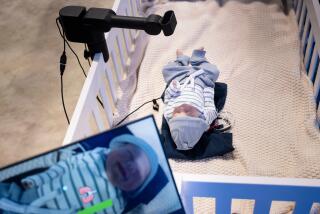Cyber-IDs Will Soon Be at Your Fingertips
- Share via
For years, companies have tried to put their finger on a form of cyber-identification that is not only secure and reliable but easy to use.
Password systems aren’t completely secure and require the user to remember passwords that in some cases are frequently changed. Scanners address these issues by relying on a user’s fingerprint. Users “register” by pressing a finger on the peripheral’s recognition pad. The device then translates the fingerprint into digital information. When users log on, they place a finger on the recognition pad and the scanner accesses a data bank. Such scanners have traditionally relied on expensive prisms for fingerprint identification and have been priced at about $500.
But a Redwood City, Calif., start-up, Digital Persona Inc. (https://www.digitalpersona.com), recently unveiled U.are.U, a PC-compatible fingerprint scanner that sells for $99. A $129 package includes software to replace the Windows 95 and 98 log-on password. The device is cheaper because it relies on a more modest plastic filament to record and read fingerprint data.
The unit is just slightly bigger than a mouse and connects via cable to the universal serial bus. The USB port has already been adopted by Microsoft and Intel and can receive images and graphic art at 1.5 to 12 megabits per second.
A separate package will enable the user to download his or her fingerprint onto a chip card. Such cards would become a kind of electronic wallet, making possible various cyber-transactions, such as accessing a bank account. That package will sell for about $180.
The company also plans to offer an Internet software kit that will enable online companies to build fingerprint recognition into their Web sites. The cost will range from $499 to $999 for systems that have between 100 and 1,000 users.
With this kit, a user registers in the server’s online database using ActiveX or Java controls and the U.are.U scanner. Once U.are.U has been enabled on the site, the user activates a special session by placing a finger on Digital Persona’s scanner. The user will be allowed access only if the system recognizes the fingerprint.
Earlier versions of scanners required placing one’s finger in precisely the same position as in the original scan and also required repeating the recognition step for verification.
“Thanks to proprietary software that runs on its own chip, once U.are.U has recorded your fingerprint, it can recognize that print from whatever position you place your fingertip on the reader,” says Fabio Righi, chief executive of Digital Persona.
The basic U.are.U system will be available next month. The Internet version should be in computer stores by June.





